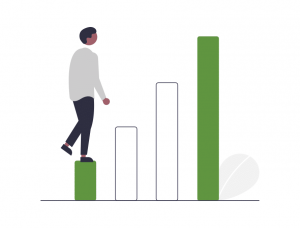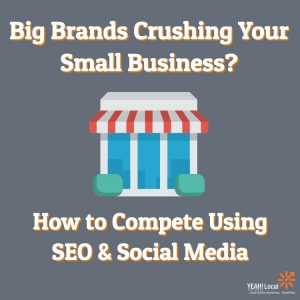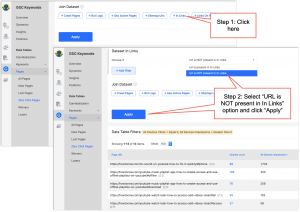This article covers several different methods to help you identify and seize opportunities to promote your site quickly and efficiently. I believe that, when it comes down to it, website promotion works best when based on the Pareto principle – that is, 20% of the pages create 80% of the traffic. This article will help you identify, optimize, and promote your best pages, the 20% that generate most of your traffic.
1. Leveraging Existing Content
As you probably know already, more and more business owners understand the importance of their website’s ranking in Google’s search results. As it is the go-to search engine for almost everyone and everything, Google has become the effective reality of the business world. Businesses simply can’t afford to rank low on its search results. It only follows that, for more and more queries the first few rankings become increasingly competitive.
In addition, despite a growing number of keyword research tools, most users still use such well-known tools as Keyword Planner, Semrush, Ahrefs, Answer the Public, and Uber Suggest. This creates two major problems. First, it means that everyone gets very similar keyword research results, and so competition for these keywords only grows. Second, it means that you are probably missing opportunities to quickly and efficiently promote pages using less-competitive keywords. Recent years have shown a rise in website promotion based on content and context, as opposed to plain ol’ keywords, which used to be enough. In direct result, content creators now feel more comfortable to write content based on the genuine interests of their target audience, rather than generic keywords.
As search engines become more sophisticated, our “conversations” with them become more and more humanlike. Google understands this and gives higher rankings to results that are calculated as relevant or consistent with “the writer’s intention,” as opposed to results that simply contain the relevant keywords. This, my friends, is a gamechanger. I believe that, when planning your 2018 content strategy, you must consider what topics or ideas might interest your target audience, regardless of whether these topics come up in your keyword research.
In the end, it doesn’t matter whether you write based on keywords or based on the interests of your audience – the next check is relevant for everyone. Use Google’s Search Console to see if your existing content has untapped potential.
How Do We Do It?
Go to Search Console → Search Traffic → Search Analytics, check Queries, and filter your results based on position, clicks, and impressions. It should look something like this:
So What Do We Have Here?
- Clicks: The number of clicks for the query. Clicking the little arrow to the right of the query would launch a new window with its Google search results.
- Impressions: The number of impressions for that query
- Position: The page’s average position (that is, ranking) for that query.
Important: This screen does not actually show you the relevant page for a given query. To find it, you need to type site:domain.com [query] in Google’s command line. Another way to find the relevant page is by using your keyword tracking tool. Just type the query to see which page it indexes.
Note: It might be a good idea to export the file as an MS Excel file or as a Google Sheet before performing this analysis.
So, now that we know what we’re looking at, let’s understand what we need to find!
Using an Excel or Google Sheet filter, I usually look for a query whose impressions are as high as possible and positioned at 1-15. The Clicks parameter would be a bonus parameter in this case. If a query looks promising (that is, high in both position and impressions), it means that it already generates some traffic, and therefore is a great candidate for optimization. Don’t fret too much if the Clicks parameter is low – it’s probably not as significant as the other two.
After we’ve identified the most promising opportunities, we need to see how competitive they are. I estimate competition based on the number of searches, referring domains, and the number of results whose title contains the query. I also make sure that my page contains the search query, though perhaps Google finds it less than optimal. If my review shows that the query is not so competitive – that’s our winner! We can now optimize that page based on our query and then sit back and wait for the improved ranking.
2. PageSpeed Optimizing
The first method made use of Google’s Search Console to identify promotion opportunities that went unnoticed. This method discusses opportunities that are easier to locate, but can still be greatly optimized for better results.
Earlier last month, Google issued two updates on site loading speed. The first update discusses their Pagespeed Optimization tool, which was previously based on the browser that ran it. Not anymore. According to Google, the tool is now based on measurements of real user experiences, which make a far better indication of how the site functions, its loading speed, and the user’s browsing experience. According to their second update, a site’s loading speed on mobile now directly and officially(!) affects that site’s ranking.
Why focus on loading speed? Because it might win us fast results without rethinking or making any strategic SEO decisions. Since loading speed is now an official ranking parameter, it is important to identify the pages that already generate organic traffic and optimize their loading speed. This method is not unlike the previous one, though the pages we are now seeking are different in nature. When it comes to actual rather than potential traffic, Google Analytics (as opposed to the Search Console) is a better, more reliable tool.
So how can we identify which pages receive consistent organic traffic? Go to Google Analytics -> Acquisition -> All Traffic -> Source Medium -> Organic Traffic with Landing Page as Secondary Dimension. You should see something like this:
So What do We Have Here?
Some of you may not be familiar with this display or with secondary dimension. These are the “landing pages” that attract most of your organic traffic, that is – the pages ranked high by Google. We therefore need to improve their loading speed. One main way of doing so by shrinking some of the site’s pictures in one of the following ways:
- Resize your pictures with this wonderful tool.
- Redefine the picture size.
I sometimes come across websites whose article thumbnails are huge, even though a hi-res picture is completely unnecessary when it is presented at 150px. The picture must therefore be resized to be much smaller.
How would I know the picture’s optimal size? By using free add-ons like Jing or Lightshot Screenshot. These add-ons allow you to take screenshots that are also measured by the pixel, to let you know the needed size. Once you have the optimal size, you can resize the original picture using Window’s old familiar Paint program. This would immediately improve your site’s loading speed, which in turn would result in a higher ranking.
Of course, in later stages, you would need to conduct a thorough SEO review, map out all existing issues, and solve them using WP-Rocket or a web programmer.
3. Sorting and Removing Low-Ranking Pages
Daniel Zrihen wrote an excellent article (Hebrew) on this topic which is summarized here for your convenience. It’s an issue that’s both easily resolved and yields quick results. In case you weren’t aware, one of WordPress’s and HubSpot’s major flaws is creating automated web pages due to of errors in templates, add-ons, etc. These automated pages usually fall in to one of these categories:
- Tag pages: These are created by incorrect tag use, inter-tag spelling errors, and tag name inconsistencies. Tags are used to catalog our online articles based on predefined topics. Each tag added to a post automatically creates a designated tag page. So, if you tag a post with the tags “Social media,” “social media,” and “SM,” you would actually be creating three different tag pages that can easily be spared from both your site and Google’s crawler.
- Multiple category pages: As in tag pages, creating multiple categories such as “Tours to Israel,” “Israel Tours,” and “Trips to Israel” would create three separate – and unnecessary – pages.
- Archive Pages: These are automated pages that archive posts by the month in which they were published. Like multiple tag and category pages, archive pages are low-quality, low-ranking, non-optimized pages that can easily be removed.
- Old Content – Hello World!: A common mistake is forgetting to delete the very first post (WordPress’s default first post), or various test posts created during programming or optimization. All these can be easily deleted.
Dozens, hundreds, and even thousands of automated pages on your site are indexed and scanned when no one – not you, and definitely not Google – can see what value these pages have for the user (see Google’s commentary here). For Google, these are pages of low value, and are ranked accordingly.
Wait, this Sounds Hard, and I Got Stuff to Do. Why Do I need This?
Note that not all sites need all the actions described here, and these are not actions that must be done regularly. And yet, identifying the problem is quite simple.
Finding the Relevant Pages
- Identify the pages using Google’s operator site (site:domain.com inurl:tag); or
- Run your site through Screaming Frog; or
- Use the site’s CMS, whatever it might be.
What to Do Once Found
After you’ve found all the relevant pages, map them based on their relevance. Identify which tags are relevant, and which tags could be combined in to one. Remember that if you’ve merged or deleted tags, set up a 301 redirection.
Important: Relevant pages must be optimized based on a broader strategy.
What Good Does That Do?
First, it improves your user’s browsing experience. Think of the average user, who moves from a clean, neat website to an archive or tag page that only contains one article. It immediately diminishes the user’s browsing experience and increases the chance of browsing away to another site.
Second, by removing unnecessary pages and maintaining good site architecture, we help Googlebot understand which pages are important. We also prevent it from indexing low-quality pages on our site, which might imply that our site’s content is also of low quality.
Important: Some sites, such as e-commerce sites, are promoted based on category and tag pages, in which case, don’t just run through these methods mindlessly. Use judgment and caution.
Summary
This article provided tools to help you identify and act upon promotion opportunities. As mentioned above, I hope these methods help you identify and further leverage your site’s 20% traffic generators.
Digital & Social Articles on Business 2 Community
(103)







